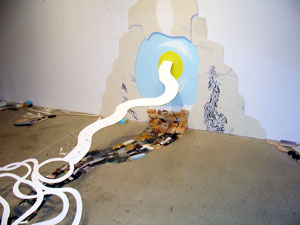In continuation of our current series on Recent MFA Graduates, another emerging artist to keep on the radar is Carrie Brantley, a printmaker and painter from Southern Methodist University.
In continuation of our current series on Recent MFA Graduates, another emerging artist to keep on the radar is Carrie Brantley, a printmaker and painter from Southern Methodist University. Brantley, expounding on her native Southern Louisiana subculture, explores the dynamics and peculiarities of casual behavior through her oil paintings and intaglio prints. In her work she poses several poignant questions, among them: is interpersonal interaction unique, or is it instead a cultural construction?
Brantley uses expressive mark making to create narrative scenes of ambiguous physical context, translating social content into an aesthetic format. Broad brush strokes, reminiscent of Willem De Kooning’s bold marks (though without the violence behind each painterly motion), pare down gestures and facial expressions to essential records of action and reaction. Brantley’s imaginative anatomical and spatial renderings evoke social relationships, rather than describe illusionistically a portrait of an individual or a location. Her angular forms and uneasy arrangements of figures are stylistically similar to German Expressionism, though unencumbered by the acrimonious overtones of that early modern movement. By removing distinguishing contextual traits, she presents a scene that can be more readily recognized for its social content.
In titling her works, Brantley also vaguely suggests narrative, though she provides only fragmentary allusions, as in After Dinner and Vows Kept. Although the phrase “after dinner” implies a certain moment during the course of a day, it does not inform the viewer who specifically is represented, where, or why. Instead, Brantley shows a nondescript living room with three figures sitting uncomfortably, spaced out, like actors across a stage set, placing the viewer in an audience position. The figure closest to the foreground is hidden almost entirely in shadow, so much so that the viewer cannot assign a gender to this person. We are left to muse about the fundamental social structure of this scene and the interpersonal dynamics that bring these three figures together. Their physical isolation from each other suggest they are strangers, although they coexist in a generically familial setting. In isolating a casual scene from explicit context, Brantley questions why a certain type of conversation or gathering is considered casual. In extension, she asks her viewers why her chosen narratives of otherwise mundane scenes are significant enough to paint.
By animatedly working and overworking her two-dimensional media, Brantley emphasizes her intimate involvement in the creation process and her individual decision making throughout. In her artist’s statement, she writes, “I must daily rid myself of the notion of a fixed vocabulary where logic and common sense tell me what is red, what is a chair, or what is a wall.” [1] She skeptically approaches these familiar physical elements as she does the equally recognizable, but less tangible social elements of ritual, spirituality, and gender roles. When accepted social behavior is reconsidered under Brantley’s hand, it no longer seems routine, but awkward. In this postmodern critique of reality, Brantley exposes cultural constructions that we may otherwise assume commonplace.
In her MFA Thesis Exhibition at Southern Methodist University’s Pollock Gallery, Brantley used Southern Louisiana as a case study for her investigation of the cultural construction of casual behavior. What would happen, you might wonder, if she were to extrapolate her social theory, comparing and contrasting social habits across cultural boundaries? What is the purpose of ingrained cultural behavior? By raising vital questions concerning the nature and origins of human interaction, she calls attention to these fundamental behaviors, which we might otherwise leave unexamined. The questions that Brantley raises, however, remain largely unanswered—they may, in fact, not have any conclusions at all.
1. Carrie Brantley, Artist’s Statement. Dallas, Texas: Southern Methodist University, 2005.
Images courtesy artist.
Catherine Deitchman is a writer living in Dallas.





